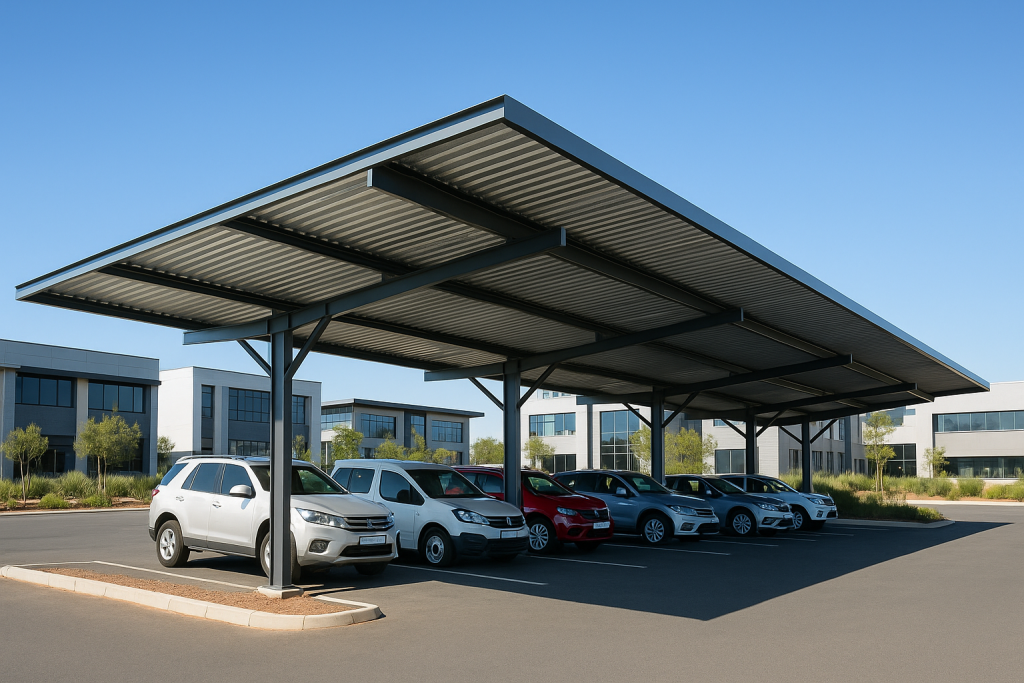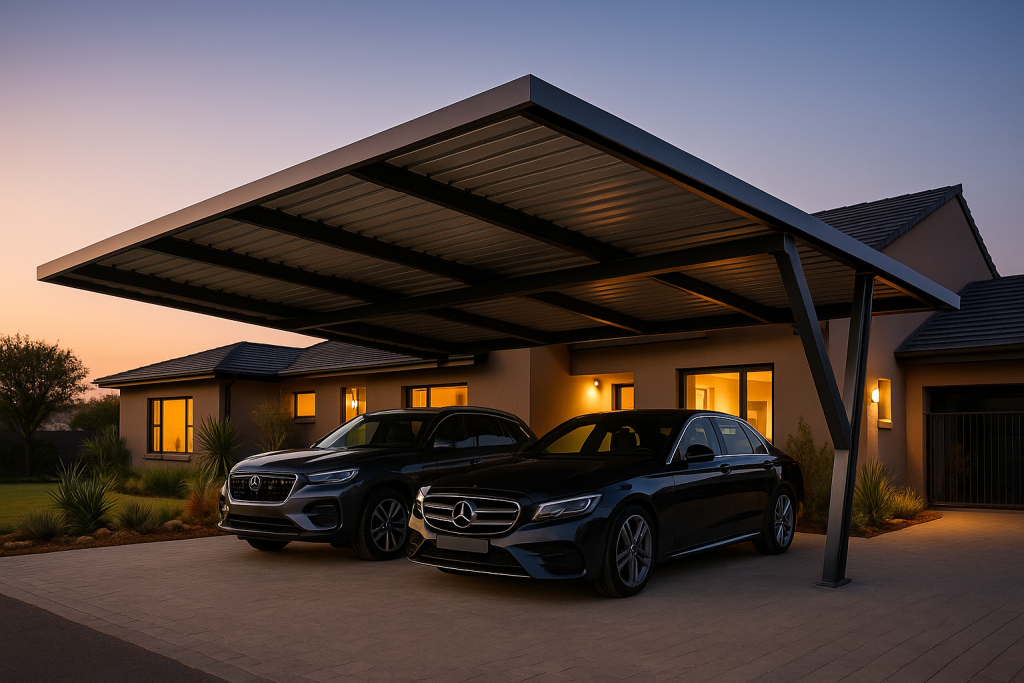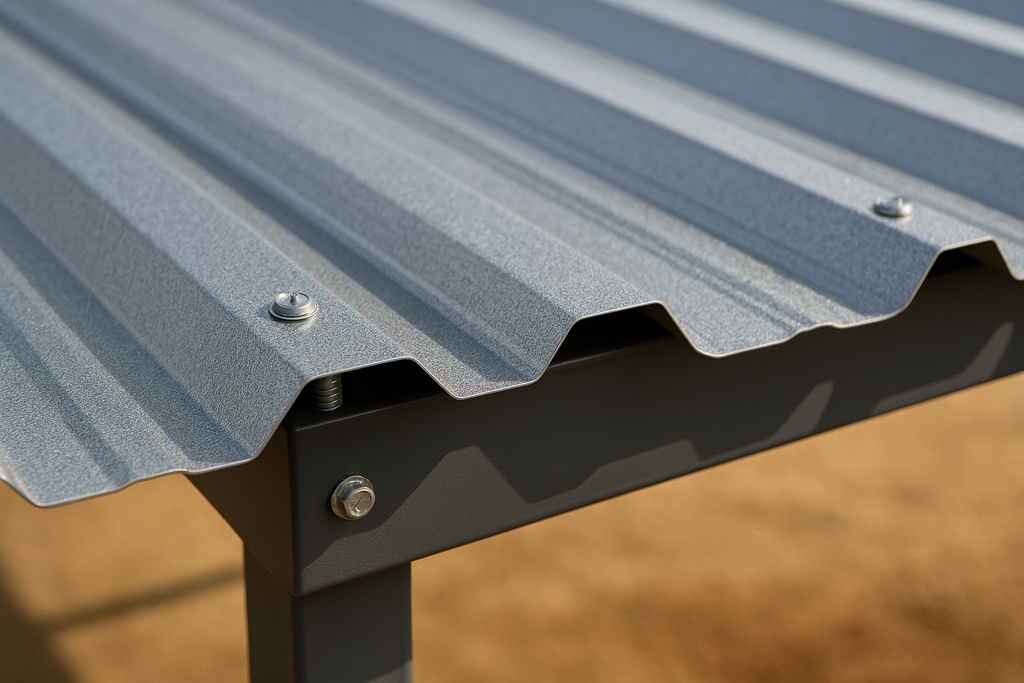Installation and Repairs of IBR Carports in Gauteng
Key Takeaways
- IBR carports offer superior strength and durability compared to other types
- Council approval is typically required for permanent carport structures in South Africa
- Professional installation costs range from R12,000 to R35,000+ depending on size and materials
- Standard single carport dimensions are roughly 3m x 6m, while double carports are 6m x 6m
- A proper foundation is essential for long-term structural stability
- Regular maintenance extends the lifespan of your IBR carport by 10+ years
What are IBR Carports?
IBR carports have become super popular in Gauteng homes, and there’s good reason for it. IBR (Inverted Box Rib) refers to the specific profile of metal sheeting used for these structures. Unlike your typical flat roof options, IBR sheets have a distinctive wave-like pattern that gives them extra strength and makes them perfect for our sometimes crazy Gauteng weather.
What makes IBR different from other carport materials? The metal sheets are pressed into a specific pattern that creates channels for water runoff while also increasing the structural integrity. This design isn’t just for show – it actually helps the carport handle heavy rain, resist strong winds, and even stand up to small hail. You’ll find that most IBR carports in Gauteng are made from galvanized steel that’s been painted or coated to prevent rust.
ProNet Shade Ports Gauteng specializes in various carport designs, including IBR options that combine practicality with visual appeal. The thickness of IBR sheets typically ranges from 0.4mm to 0.8mm, with the thicker options providing better durability but at a higher cost. Most homeowners go for the middle option (0.5mm or 0.6mm) for a good balance of strength and affordability.
These carports aren’t just functional – they can also look really nice when properly designed. The range of available colors means you can match your carport to your home’s existing color scheme. And unlike some other carport materials, IBR doesn’t fade as quickly in our harsh South African sun.

Do Carports Need Council Approval in SA?
Yes, most carport installations do need council approval in South Africa, but the exact requirements vary depending on where you live. This is a question lots of homeowners ask, and it’s an important one to get right.
For permanent structures like IBR carports, you’ll typically need to submit building plans to your local municipality for approval before starting construction. The plans need to show exactly how the carport will be built, what materials will be used, and where it’ll be located on your property. In Gauteng specifically, you should check with your local council as regulations can differ between Johannesburg, Pretoria, and smaller municipalities.
Some councils have rules about how close structures can be to property boundaries – usually they must be at least 1 meter away from side boundaries and 1.5 meters from the street boundary. There’s also often a limit on how much of your property can be covered by structures.
The approval process can take anywhere from a few weeks to a couple months, so it’s important to plan ahead. If you build without proper approval, you might face fines or even be forced to remove the structure completely.
Some smaller, temporary carports might not need full council approval, but it’s always best to check rather than assume. ProNet Shade Ports Gauteng can help navigate the approval process as part of their installation service.
One thing to be aware of – if you live in an estate or complex with a Homeowners Association (HOA), you’ll probably need their approval too, even if the council doesn’t require it. HOAs often have their own rules about what carports can look like to maintain the overall appearance of the neighborhood.
Do I Need a Foundation for a Carport?
Absolutely, you need a foundation for an IBR carport – this isn’t something you wanna skip! The foundation is basically the whole thing that keeps your carport standing straight and secure for years to come.
For IBR carports in Gauteng, there are a few foundation options that work well:
- Concrete footings: These are holes dug at each post position, filled with concrete. The posts are then embedded directly in these footings.
- Concrete slab: A full concrete slab underneath the entire carport area, providing maximum stability.
- Paved base with post footings: A combination approach where the ground is paved, and concrete footings support the posts.
The type of soil in your area plays a big role in determining what foundation you’ll need. Gauteng has varied soil conditions – some areas have expansive clay soils that move a lot with moisture changes, while others have more stable ground. A professional installer will assess your specific site before recommending a foundation solution.
What happens if you try to skip the foundation? Your carport might seem fine at first, but over time, you’ll likely notice posts starting to lean, the roof becoming uneven, or the entire structure becoming unstable. During heavy rain or strong winds, an inadequately anchored carport could even become dangerous.
The cost of creating a proper foundation is typically included in quotes from professional installers like ProNet Shade Ports Gauteng, but it’s always good to confirm this detail when getting estimates.
For DIY enthusiasts, the foundation is the most technical part of the installation and requires careful measurement and leveling. If you’re not confident in your ability to create a proper foundation, it’s worth hiring professionals at least for this portion of the project.
How Much Does a Carport Cost in South Africa?
The cost of carports in South Africa varies quite a bit depending on several factors. For IBR carports specifically, prices in 2025 typically range from R12,000 for a basic single carport up to R35,000 or more for larger, more complex designs.
Here’s a breakdown of what affects the price:
| Factor | Impact on Cost |
|---|---|
| Size | Single carports (3m x 6m) cost 40-50% less than double carports (6m x 6m) |
| Material thickness | 0.4mm IBR sheets cost about 20% less than 0.6mm sheets |
| Height | Higher clearance increases cost by 15-25% |
| Finishing | Painted vs. galvanized finishes affect price by 10-15% |
| Foundation type | Concrete slab foundations add 25-30% compared to simple footings |
The cheapest options are typically shadeport structures which use fabric instead of IBR sheeting, starting around R7,000-R10,000. Traditional IBR carports start around R12,000 for single options and R20,000 for double carports with standard features.
For something with more features, like a cantilever carport (which doesn’t have posts at the front), expect to pay a premium of 20-30% over standard designs due to the more complex engineering required. Similarly, pyramid carports with their distinctive roof shape tend to cost 15-20% more than flat-roofed versions.
Installation costs are usually included in the quoted price, but some companies charge separately for this. Always check if the quote includes:
- Council approval assistance
- Foundation preparation
- Material delivery
- Labor costs
- Cleanup after installation
Most reputable companies in Gauteng offer warranties ranging from 1-5 years on both materials and workmanship. It’s sometimes worth paying a bit more for a company offering a longer warranty period.
For budget-conscious homeowners, semi-cantilever carports offer a middle ground between standard and full cantilever designs, with prices sitting about 10-15% higher than standard models but less than full cantilever options.

What is the Standard Carport Size in South Africa?
The standard carport sizes in South Africa are pretty consistent, but they do vary based on how many cars you need to accommodate and sometimes the specific vehicles you own. Knowing the right size is really important before you start gettin’ quotes.
For a single carport, the typical dimensions are:
- Width: 3.0 to 3.5 meters
- Length: 5.0 to 6.0 meters
- Height: 2.1 to 2.4 meters (at the lowest point)
Double carports usually measure:
- Width: 5.5 to 6.0 meters
- Length: 5.0 to 6.0 meters
- Height: Same as single carports
These dimensions allow enough space for standard vehicles, with room to open doors and move around the car. However, if you have larger vehicles like SUVs, bakkies, or vans, you might want to consider custom dimensions. For example, many SUV owners opt for slightly wider carports (3.5 to 4.0 meters) and higher clearance (2.4 to 2.7 meters).
Clearance height is especially important to consider. The standard 2.1 to 2.4 meters works for most sedans and hatchbacks, but if you have roof racks, a high vehicle, or might want to park something taller in the future, going with extra height is a good idea.
For wall-mounted carports, the dimensions might be slightly different since they attach to an existing wall on one side. These typically save about 0.5 meters in width compared to free-standing options.
When measuring for your carport, remember to account for:
- Vehicle dimensions plus door opening space (approximately 1 meter on each side)
- Space to walk around the vehicle (at least 0.5 meters)
- Any additional storage you might want underneath the carport
- Slope of the land and drainage requirements
Most professional installers will visit your property to take measurements and recommend the best size for your specific needs and space constraints.
IBR Carport Installation Process in Gauteng
The installation process for IBR carports follows several key steps to ensure a sturdy, long-lasting structure. Understanding this process helps you know what to expect when you hire professionals or if you’re brave enough to tackle a DIY project.
First up, site preparation is crucial. This involves clearing the area of any obstacles, vegetation, or debris that might interfere with the installation. The ground needs to be relatively level, though slight slopes can be accommodated for drainage purposes. Most Gauteng installers will start by marking out the exact position of the carport using string lines and measuring tools.
Next comes the foundation work. For most IBR carports, concrete footings are created for each support post. Holes are dug to below frost line (usually 500mm deep in Gauteng) and filled with concrete. Some installations might require a full concrete slab instead, especially for larger structures or in areas with problematic soil conditions.
Once the concrete has cured (usually 24-48 hours), the frame construction begins. Steel or aluminum posts are secured to the footings, either by being cast directly into the concrete or attached using post brackets. The horizontal beams are then attached to create the basic frame structure. This is when the installer makes sure everything is perfectly level and square.
The roof structure comes next. Purlins (horizontal supports) are attached perpendicular to the main beams to create the framework that will support the IBR sheets. The spacing of these purlins is critical and depends on the thickness of the IBR sheets being used.
Finally, the IBR sheets are carefully positioned and secured to the purlins using special roofing screws with rubber washers that prevent leaking. Overlapping between sheets must be done correctly to ensure proper water runoff. Flashing and guttering might be added at this stage if included in your design.
The whole process typically takes 2-3 days for a standard carport, though larger or more complex designs might take longer. Weather can also affect the timeline, as concrete curing requires dry conditions and working with large metal sheets in high winds can be dangerous.
Professional installers will also handle the cleanup, removing all construction debris and ensuring the area is left neat and tidy. They should provide you with information about maintenance and care for your new carport before they leave.
Maintaining and Repairing Your IBR Carport
Keeping your IBR carport in good shape isn’t hard, but it does need a bit of regular attention. With proper maintenance, these structures can easily last 15-20 years or more in Gauteng’s climate.
One of the most important maintenance tasks is simply keeping the roof clean. Leaves, twigs, and other debris can collect on the roof surface and in the channels of the IBR sheeting. This debris traps moisture, which can lead to corrosion over time. A simple rinse with a garden hose every few months is usually enough to keep things clean, though you might need to climb up there carefully to remove stuck debris occasionally.
Check for loose fasteners and screws at least once a year. The expansion and contraction of metal in Gauteng’s fluctuating temperatures can cause screws to loosen over time. Tightening them is a simple task that prevents bigger problems later on. If you notice any missing or damaged screws, replace them immediately with proper roofing screws that include rubber washers.
Keep an eye out for early signs of rust or corrosion, especially at cut edges and where sheets overlap. These areas are most vulnerable to moisture penetration. Small rust spots can be treated with rust converter products followed by touch-up paint that matches your carport color. Catching these early prevents the need for more extensive repairs later.
For more serious issues like bent or damaged IBR sheets from falling branches or severe weather, replacement might be necessary. Individual sheets can usually be replaced without disturbing the entire structure, though this is typically a job for professionals unless you have experience working with metal roofing.
The supporting structure also needs attention. Check for any signs of post movement or leaning, which could indicate foundation issues. Posts should be straight and firmly anchored. If you notice a post becoming loose or leaning, it’s best to call in professionals to assess and repair the foundation before the problem worsens.
Gutters, if installed, should be kept clear of debris and checked for proper water flow during rains. Poor drainage can lead to water damage around the foundation of your carport.
For painted surfaces, expect to need a fresh coat every 5-7 years to maintain appearance and protection. When repainting, make sure to use paint specifically designed for metal surfaces and appropriate for outdoor use. Proper preparation including cleaning and light sanding of the surface will ensure better paint adhesion and longer-lasting results.

Frequently Asked Questions
How long does it take to install an IBR carport?
Installation typically takes 2-3 days for a standard carport, depending on size and complexity. Weather conditions and soil type can affect this timeframe.
Can I install an IBR carport myself?
While DIY installation is possible for those with construction experience, professional installation ensures proper structural integrity and compliance with local regulations. The foundation work particularly requires specific knowledge and equipment.
How long will an IBR carport last in Gauteng?
With proper maintenance, an IBR carport can last 15-20 years or more. The galvanized coating provides excellent protection against Gauteng’s climate.
Can IBR carports withstand heavy rain and hail?
Yes, IBR sheeting is designed specifically to handle heavy rainfall, and the corrugated design provides good strength against hail. Thicker gauge sheeting (0.6mm or 0.8mm) offers better protection against larger hailstones.
Are IBR carports noisy during rain?
IBR sheeting can be somewhat noisy during heavy rain compared to tile or thatch alternatives. However, insulation options are available that can significantly reduce noise.
Can I extend my IBR carport in the future?
Yes, most IBR carports can be extended or modified later. It’s best to discuss potential future expansions with your installer during the initial design phase.
Do IBR carports increase property value?
Well-designed and professionally installed carports typically add value to properties in Gauteng, offering protection for vehicles while improving the property’s appearance and functionality.
Can solar panels be installed on an IBR carport roof?
Yes, IBR carports can be designed to support solar panels, though this may require additional structural support and should be planned during the initial design phase.
What maintenance does an IBR carport require?
Regular cleaning, checking for loose fasteners, addressing any rust spots promptly, and repainting every 5-7 years are the main maintenance requirements.
Can IBR carports be insulated?
Yes, insulation can be added beneath the IBR sheeting to reduce heat transfer and noise. This is particularly valuable in Gauteng’s hot climate.



